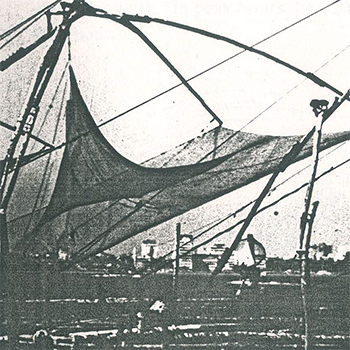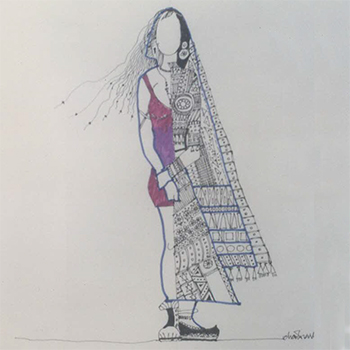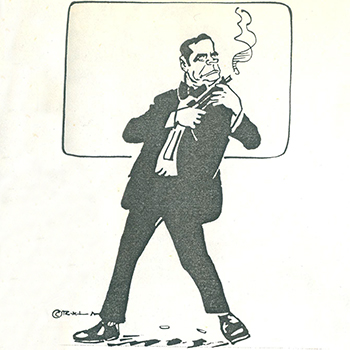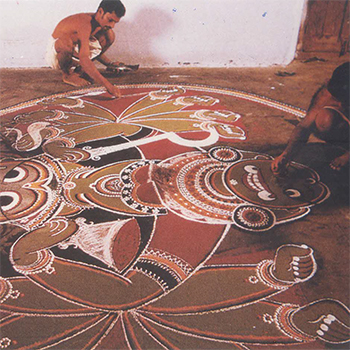Product Design
Batch 1994-1996
(14 items)
Product DesignBatch 1994-1996
(14 items)
(14 items)
by Adamya Ashk
Bamboo and Bamboo Crafts
Bamboo is an important natural resource for a country like India. Crafts in bamboo have reached a high state of development in our country. But with the coming of colonialism and subsequent industrialization, the subcontinent saw a gradual decline in the practise of crafts of all types. Bamboo craft was certainly no exception, although it continued to flourish in the rural and remote regions where other materials were scarce. Today, there is a need to see crafts as a means for economic upsurgence and as a symbol of strong cultural identity in the face of blatant industrialization. Bamboo craft is ecologically sound on the one hand, while on the other hand, it can be seen as a great employment generator (Kaley 1994). This makes a strong case for rejuvenating this craft form.
Design Input into Bamboo Craft
Design has evolved from craft. Design inputs into bamboo craft can be an important way of affecting this rejuvenation. It has the potential to bring much-needed innovation to bamboo craft, making it economically viable and competitive with industrially produced artifacts. This is something that traditional craft knowledge, which shows gradual improvement over a long time, cannot grapple with (Rao, 1995).
The Problem of Simulation
Yet designers with formal training have little or no understanding of bamboo craft. Bamboo crafts also pose a great difficulty in terms of simulation. The designer can simulate a plastic bucket and experiment with the form, but without making a bamboo basket, it is impossible to explore its formal capabilities. So, for meaningful participation of designers, methods of simulation, which provide for creativity that is free from the necessity of having the ability to make the actual products, are essential.
Apart from this, the designer has to explain his concepts to the craftsman, in which he faces great difficulty because the traditional methods of representation are limited in their ability to convey something as complex as bamboo woven forms. This brings us to the purpose of this project, that of using computers for the simulation of bamboo weave forms.
Simulation on the Computer
The computer is already an important tool for the simulation of artefacts of many materials. It provides a new way of simulating concepts in three-dimensional images. Computer-generated images also offer a certain precision, which can be used to convey the designer’s intentions in a better way than previously possible. This attribute significantly points to its use for simulating and generating images of bamboo weave forms, which can convey much more than product renderings and other methods of representation.
by Amin Thakker
Kutch is an ancient land located in the north-western region of Gujarat, the westernmost state of India. It has a rich history due to its strategic location on the historic route to India. It is bordered by the flat desert locally known as the "Rann" on the north and the east. The Rann is a unique feature found nowhere else in the world. Kutch is bounded by the Arabian Sea to the west and southwest and by the Gulf of Kutch to the south. The Kutch region can be divided into three parts, running more or less horizonally in the east-west direction. The village of Khavda is known for its printing work called Ajhrak and also for leather crafts.
The largest of the three is the Rann, extending towards the southeast. The central belt is known as Banni, a name derived from the area's rice cultivation. However, the land yields good quality grass if the rain is sufficient. It is now a major cattle breeding area, supplying milk to the major settlements to the south. The area has good potential for dairy farming if somehow sufficient water could be made available. There are no urban settlements in the Banni; in fact, not even villages are found. However, there are over forty beautiful semi-nomadic hamlets. The coastal area in the south is the most urbanised part of the region. The sea routes were a major factor contributing to their development in the past. Most of the larger settlements lie within these belts.
The entire region as a whole is very dry, and all the places you see around you get to see sand, thorns, and stones all over the place. This dryness of the land has made people very colourful in their lives. The average population density of the entire region is around 20 people per sq. They are distributed in pockets, either as a village or at a great distance. Previously, there were very few connecting roads. Now state transport buses are available and they reach almost all the villages in the entire region, as well as the tarred roads that cut across almost the entire region.
by Asok Abraham George
The underlying themes of this project are ethnicity and modernisation. The task was to identify a vernacular and historical pocket in a metropolis and study its origin and growth, its religious and cultural roots, as well as the changes due to the onslaught of modernization and how traditional culture has endured or adapted itself to the present times. The study included the place-its sights, smells, images, pulses. architecture, etc., as well as its people—their needs, feelings, desires, and fears. The vernacular pocket and its relationship with the city as a whole, the cross-cultural influence, and possible conflicts and clashes between them were looked into.
The vernacular or historical pocket chosen for the project is the ancient township of Fort Cochin, once a major trading centre but now just a small pocket in the metropolitan city of Cochin, the commercial capital of Kerala. This unique urban settlement was chosen because of the component of plurality, or the existence of multi-ethnic groups that form its population. Unlike most of the vernacular pockets that exist in other cities like Bombay, this pocket is inhabited not by a single community but by different people, with different religious and cultural identities.
The study tries to find if a common denominator exists among all these groups, something that makes it possible to collectively identify the people of this area. Due to the limitations of time, the study was restricted to the four main communities of the area, namely the Christian, Muslim, Hindu, and Anglo-Indian communities. Other minority communities which exist in the area, such as Gujaratis, Konkanis, Jews, Jain, etc., have not been included. Most of these communities are settled in Mattanchery, another historic pocket adjacent to Fort Cochin.
The study includes the documentation of people, places, objects, phenomina, activities, rituals, festivals,streets, buildings etc. A brief outline of the unique urbanisation in Kerala and the differences it has with urbanisation in Kerala and the differences it has with urbanisation in the rest of India is included in the study. A brief write-up on the history and the present scene in Cochin is also included.
The study has not ended with this report. As a part of four similar projects undertaken at the same time at different places, the study has sparked off a quest within ourselves, a thought for human values, and a hope that we shall not only become good designers, but more importantly, better human beings.
by Chandrashekhar Madhusudan Wyawahare
The term "ethnic" has a lot of importance in this fashion industry. This term has a lot of importance today. Its origin lies in the traditions and customs of India. The various kinds of cultural backgrounds have got their own colours, fabrics, and so do the stitches. It has also got its handicrafts. Because of the strong cultural background, fashion designers have been able to explore handicrafts and traditional items in a modern context.The designers are doing lots and lots of new stuff based on the glory of the past, but they are actually in the process of "search." The search for an ethnicity in the modern era.
Designers experiment with existing traditional art forms such as embroidery, mirrorwork, tie and die, and so on, and end up combining Indian designs with fabrics from the west. It ends up with a feeling that ethnicity has been explored at a very superficial level. The dynamics of a good combination are contoured by its basic patterns, for example, the ghaghras. Its basic patterns, plains or printed, are the basic things associated with the ghaghra, but topping the hierarchy is the mirrorwork and the embroidery. Easily the most formal and elegant of all the ghaghras, it stands out when worn with the backless choli, silver ornaments, and the dupatta. Is the ethnicity of the fabric found in the utilisation of the fabric?
Showing ethnic has become bolder and now seems to follow certain metaphors. Some of the designer's conceptions are very bold and are regulated by the wildness and the vibrant Indian colours. For example, Suneet Verma’s creation is symbolised by the tantric collection, which is modern and ethnic and not modern and ethnic. Sarees with exciting bustiers and salwar kurtas with dupattas in bright colours and using various design methodologies such as tie and die, embroidery with applique, painted effects, block printing with the nalamboli type scripture letter forming the border. The colours used are also very bold and pure.
by Debasish Mahapatra
Years ago, when he was "bigger,better, Bond and beyond", in those legendary Bond sagas like Dr. No and Goldfinger, Sean Connery cried out in anger: "I’ve always hated that damn James Bond. I’d like to kill him!". The rancour was understandable. For here was an image that had grown larger than the actor: a fictitious character who had gained iconic proportions as the one-man army against evil; and a celluloid series that promised to go on indefinitely, despite the falling grandeur, increasing pyrotechnics, failing histrionis, and dwindling charisma... and yet it goes on.
Such is the saga of the super secret agent who emerged out of the imagination of Ian Fleming in 1952 and went on to become one of the most popular and legendary characters, spanning four decades, eighteen films, and fourteen Ian Fleming novels, including a number of short stories. Today, James Bond is history, which is not dead but ever alive and kicking-neither shaken nor stirred.
It is a truly remarkable achievement for an intensely personal creation, created, initially, as a money spinner and a means of escape for its author. In return, James Bond 007-license to kill, has provided escape and enjoyment for 100 million readers and one and a half billion cinegoers, and has earned a permanent place in the world’s consciousness.
James Bond has become a worldwide cult figure, crossing all race and language barriers and proving he is something much more than Secret Agent 007! What is it about this character that stirs, grips, and mesmerises in celluloid as well as in pulp? Many critics and authors have attempted explanations for it: Len Deighton; Raymond Chandler; Kingsley Amis; John Le Carre. Film and Filming, the prestigious cinema magazines, stated: "James Bond is not a screen hero, he is an institution, and as such has influenced world affairs, art, music, motion pictures, and fashion."
Critics have attributed his appeal to'sex, sadism and snoberry’; the films have been panned for their unheatable blend of conspicuous consumption, brandname snobbery, colour supplement chic, comic-strip sex and violence, and technical wizardry. Fleming himself generally felt that Bond should not be analysed too closely and said; They’re reading too much into the man—he's not all that important. This may be so, but there is unquestionably something in the Bond formula which still leaves people the world over asking for more, even though the fantasy remains the same. A new world, new threats, new enemies, yet the only man who can save the world is still James Bond: England’s dream do-gooder who carries on the good work long after the sun has set.
by Gautam Satalkar
An Indian industrial designer was asked to suggest a new colour shade for the newly launched Maruti Zen. The colours popular for the similar cars by Maruti, the 800, were Maroon Red, Dark Blue Grey, and Dark Green Grey. Now the company wanted a new shade that would cater to the female market.
Study of the psychological setup of the mind of the typical Indian woman played a key role in this problem. The new colour chosen by the designer was lemon yellow, which the company officers were reluctant to introduce. The designer somehow convinced them, and in reality, the colour shade proved to be very popular, especially amongst women.
Color and light play a key role, though generally unrecognized, in our lives. The above example shows the same. It is an example that shows the same. It is an example of the proper use of colour for the product. But many a time, the colours are used without giving proper thought to the psychological and psychological effects of the colours. This leads to bad colour design, which can cause anxiety, stress, and visual disorder and be the host to many other problems.
There have been numerous attempts by people all over the globe to understand the role of colour in human life. Many experiments have been done in history to detect the influence of colours on the human mind, both scientific and mystic. The main hindrance towards creating a set of identified rules or an elaborate theory on the behaviour of the human mind with respect to colours is that the results of all such experiments are subjective. Now, the days have changed and science has emerged with new tools for research. Today, thanks to sophisticated techniques of research and analysis, we know that colour affects cortical activation (brain waves), functions of the autonomic nervous system (which regulates the body’s internal environment), and harmonal activity, and that colour arouses definite emotional and aesthetic associations. In short, our response to colour is total; it influences us both psychologically and psychologically.
by Lalitesh Mandrekar
Broadly defined, a joint is a structural relation between two individual bodies so that mechanical forces are transmitted from one body to the other. But many other aspects, such as aesthetics and compatibility with the system or product functions, also contribute to designing a joint. This project is a study of various joints in modular systems and focuses on problems related to panel joinery systems. Various principles in joinery are analysed and some different ideas are suggested for the joining of FRP panels.
- About modular joints:
- Joints in modular systems are designed for a particular set of modules considering their sizes ,shapes, materials and variations.
- Modules and joints are developed together, and joints add to the character of a modular system.
- Joints determine the configuration of modules.
- They allow fast assembly and knock-down of the prefabricated modules.
- Modules and joint elements are reusable after knock-down without any work on the material.
by Madhu KS
by Poornima K Shenoy
by Satish Patil
Today, we, as users, are surrounded by thousands of products, each contributing to our lives in some other way. The list of products is endless, from tooth brushes to sky-scrappers to... All products are designed to perform certain functions, physically or otherwise. The vehicles we use are not only for transportation but also as status symbols. The clothes I wear show which class I belong to. I must have a wall clock that will not only show time but will match my sense of beauty and go along with the decor in my drawing room. The shoes that I wear for going to the office will be different from the ones that I will prefer for a picnic. Thus, I have different criteria as to what my shoes should look like in different conditions. Electronic equipment in houses which are more playful. Thus, under conflicting visual requirements, we live in a complex visual environment which is generated by thousands of man-made objects. And at times, there are chances that it goes beyond control.
A quote reads, "We live surrounded by too much visual squalor that is man-made, and living in a visual slum is hardly likely to foster the development of an emotional experience." Each product form is designed to have certain aesthetic implications and expressive or symbolic meaning. And if we don’t control it, there is the possibility of visual chaos. Before looking at these aspects, let us look into the historical perspective of the evolution of form and the development of the human sensitivity towards form.
by Shantanu Panse
Tooling is a prime consideration in the decision-making process involved in the planning of the manufacture of any product. It is obvious that because the tooling costs are part of the manufacturer's investment, these costs must be recovered as part of the price of the product. Therefore, before the decision is made to produce a product, the manufacturer must make very detailed plans with regard to the identification of the required tooling and the estimating of the tooling cost. When the tooling costs have been determined, they will be combined by estimates of manufacturing costs, marketing costs, desired profit margins, and various other considerations. It cannot be over-emphasised at this point how important it is that the forecasted costs are accurate. This is particularly true for the estimated tooling costs. In most industries, the tooling costs represent a substantial part of the investment. Consequently, an error or an underestimate of the total tooling costs could mislead the management into undertaking an unprofitable venture.
The use of plastics as tooling materials has provided many new opportunities for tool engineers to advance the state of the art and improve tooling costs. The very dynamic nature of the plastics industry promotes constant change and improvement. Through the continued development of new materials, new applications, and new tool fabrication techniques, the plastic tooling industry has steadily grown.
by Sunil William Moothedath
This project, entitled fivefoldness in 2D and 3D, was taken up due to the special relevance it has that it is one of the most widely occurring forms of symmetry in nature, especially in the plant kingdom. In this project, it was decided to look into the meaning of symmetry, the various aspects of expression of fivefold symmetry and its possible connection with weaving in bamboo.
The first part of the project involves mainly the documentation of symmetry and fivefoldness. The second part consists of the exploration of bamboo weaving in 2D and its exploration into 3D.
The main aim of this project was to get a better understanding of symmetry, especially fivefold symmetry, and to open a new direction for exploration into bamboo weaving using fivefoldness in 2D and 3D.
by Toa Mukerji
"Before the city, there was a hamlet and the shrine and the village: before the village, the camp, the cache, the cave, the caira, and before all these, there was a disposition of social life that man plainly shares with many other animal species." – Lewis Mumford, The City in History
The aim of this study was to study the conflicting coexistence of ethnicity and modernization arising in a city.
From various other aspects denoted by this idea, that of studying the life of a community as a whole; from their arrival to their present status; the development of a lifestyle in its totality, within the fabric of an urban settlement, formed the central concern of my efforts.
The city of Bombay offers many such examples, existing in vernacular pockets throughout the island. The existence of such havens of tradition can only be explained by looking towards the development of Bombay, which has not been like that of any traditional Indian city. Out of these, Girgaum, Mazgaon, Bandra, Bhynder, and Mahim come to mind immediately. In all of these precincts, communities have settled more than 200 years ago, some even 400 years ago, in search of economic stability around or near centres of occupation.
The vernacular pocket of my interest was Mazgaon, where the 250-year-old Matharpacady village exists, inhabited mostly by the East Indian Christian community. My study includes a brief introduction to the city of Bombay, the pocket and its origin, the images of the community-its roots and traditions, the families living in Matharpacady-their present status and growth with time, the changes with time in the traditions and lifestyle of the people in Matharpacady and in prominent land marks as a result of the onslaught of modernization.
by Zoeb Kanorwalla













